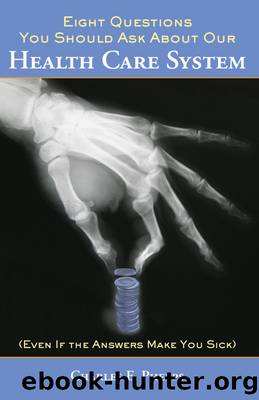Eight Questions You Should Ask About Our Health Care System (Even if the Answers Make You Sick) by Phelps Charles E

Author:Phelps, Charles E.
Language: eng
Format: epub
Publisher: Hoover Institution Press
* * *
1. One caveat: if the workerâs wages are at or near the legally mandated minimum wage, itâs impossible to have wages fall sufficiently to offset costs of health insurance premiums paid by the employer. The consequence then is often a loss of jobs in the market rather than offsetting wages.
2. âTax expendituresâ are defined as reductions in tax revenue by legislative reduction in taxation rates (possibly to zero) on certain revenue categories. The largest three are exemption of contributions to retirement plans, lower rate of taxation of capital gains, and exclusion of employer-paid health insurance premiums.
3. Other estimates almost double this number (Helms 2008, Figure 2.5). This estimate includes standard âtax expenditureâ calculations of the Joint Committee on Taxation, but also includes amounts not included in its earlier estimates. The difference centers on interpretation of Section 213 deductions (medical expenses above 7.5 percent of income). Earlier estimates presumed that disallowance of the employer premium payments would still allow individuals to deduct the costs under Section 213. The new estimates note (correctly) that full repeal of the exemption would not permit such a deduction under Section 213, hence increasing the estimated tax expenditure from earlier estimates.
4. The recession will cause much larger deficits for 2009, and probably 2010 and 2011. But the 2008 figure gives a reasonable (perhaps low) assessment of the steady-state story.
5. This estimate calculates the average of each taxpayerâs marginal tax rate (MTR) and uses that to estimate each personâs taxes saved by having income in the form of employer insurance payments rather than cash. Hereâs how the calculation works: the MTR is the proportion you pay of the next dollar you would earn. If you are in a 15 (or 22 or 28 or 33) percent federal income tax bracket, thatâs part of your marginal rate. But the complete MTR includes not only the federal income tax rate but also state and local income taxes, social security taxes (employer and employee contributions), and the 1.5 percent Medicare tax. The complete MTR averages to about 33 percent in the U.S. population (Congressional Budget Office 2005). If you get $1,000 as employer-paid insurance rather than cash, you save $1,000 times your marginal tax rate. So, on average, the tax subsidy saves people about one-third of the cost of their health insurance.
6. Economists widely accept the notion that economic activity (measured by taxable income) expands when marginal tax rates fall. The debates center on how large the effect really is. If large enough, income tax revenues actually increase as tax rates fall (the Laffer Curve effect). Most current estimates suggest that the effect is not large enough to actually increase revenues with a marginal tax rate cut (Giertz 2009), but thatâs not the issue when the tax rate cut is combined with an increase in the tax base through elimination of the employer-paid insurance exclusion. If Congress were to repeal that exclusion, an appropriate cut in marginal tax rates and the expanded taxable income base would assuredly both expand tax revenues and increase economic activity.
Download
This site does not store any files on its server. We only index and link to content provided by other sites. Please contact the content providers to delete copyright contents if any and email us, we'll remove relevant links or contents immediately.
Introduction to Social Work Practice : A Practical Workbook by Herschel Knapp(285)
Selective Oxidation Catalysts Obtained by the Immobilization of Iron (III) Porphyrins on Layered Hydroxide Salts by Fernando Wypych Shirley Nakagaki & Guilherme Sippel Machado(276)
How Data Happened by Unknown(267)
Global Health Governance and Commercialisation of Public Health in India by Anuj Kapilashrami Rama V. Baru(221)
Unmasked by Emily Mendenhall(184)
Curing Cancerphobia by David Ropeik(174)
The Pandemic Divide by Gwendolyn L. Wright Lucas Hubbard and William A. Darity Jr(160)
Restoring Quality Health Care by Scott W. Atlas(150)
Feminist Global Health Security by Clare Wenham(150)
FALSE PANDEMICS: ARGUMENTS AGAINST THE RULE OF FEAR by Wolfgang Wodarg(147)
Transforming Health Care Scheduling and Access: Getting to Now by Gary Kaplan(145)
Oversight and Review of Clinical Gene Transfer Protocols: Assessing the Role of the Recombinant DNA Advisory Committee by Rebecca N. Koehler(144)
The Making of a Pandemic: Social, Political, and Psychological Perspectives on Covid-19 by John Ehrenreich(140)
Pandemic India by Arnold David;(139)
Into Africa, Out of Academia by Kwan Kew Lai(129)
Insane Society: A Sociology of Mental Health by Peter Morrall(129)
The Metropolitan Academic Medical Center by David E. Rogers Eli Ginzberg(128)
Psychosocial Interventions for Mental and Substance Use Disorders: A Framework for Establishing Evidence-Based Standards by Mary Jane England(128)
Risk Communication and Infectious Diseases in an Age of Digital Media by Anat Gesser-Edelsburg Yaffa Shir-Raz(127)
